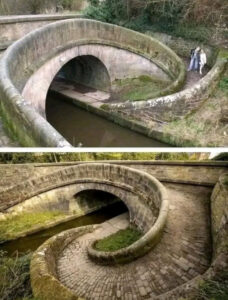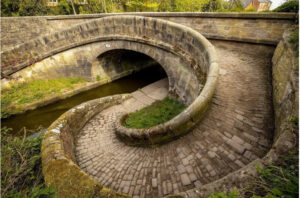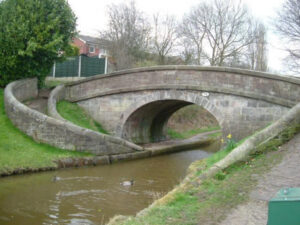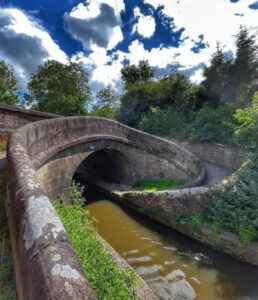
The Birth of an Innovation
In the heart of northern England, along the historic Macclesfield Canal, stands a remarkable testament to Victorian engineering ingenuity – the Snake Bridge. Opened in 1831, this unique structure wasn’t just another canal bridge; it represented a breakthrough in solving one of the most pressing challenges of canal transportation during the Industrial Revolution.


A Problem Worth Solving
During the height of Britain’s Industrial Revolution, canals were the arteries of commerce, with horses towing boats laden with coal, textiles, and raw materials. However, a seemingly simple problem plagued this system: whenever a horse needed to cross the canal, the boat had to stop, the tow rope had to be detached, and precious time was lost in the process.
Engineering Meets Innovation
The Serpentine Solution
The Snake Bridge’s genius lies in its spiral design.
Instead of a straightforward crossing, the bridge features a remarkable 360-degree spiral ramp on each side. This serpentine path, from which the bridge derives its name, allowed horses to cross the canal without ever needing to detach from their boats – a simple yet revolutionary solution that kept commerce flowing smoothly.
Built to Last
The bridge’s construction speaks volumes about Victorian engineering prowess. Using a combination of cast iron, brick, and stone, its builders created a structure that could withstand the constant tramping of heavy horses. The ramps were thoughtfully designed with raised brick patterns to prevent horses from slipping, showcasing the attention to detail that went into every aspect of its construction.
Legacy and Present Day
While the days of horse-drawn boats are long gone, the Snake Bridge continues to captivate visitors to the Macclesfield Canal. It stands not just as a functional crossing, but as a monument to human ingenuity. Modern tourists can still trace the spiraling path that countless horses once trod, marveling at how such a simple yet elegant solution could have such a profound impact on industrial transportation.
A Timeless Teaching
The Snake Bridge serves as a powerful reminder that sometimes the most effective solutions come from thinking differently about everyday problems.
In our modern era of high-tech solutions, this 19th-century innovation continues to demonstrate how creative engineering can solve practical challenges in beautiful and enduring ways.


Conclusion
The Snake Bridge represents more than just an interesting architectural curiosity – it embodies the spirit of innovation that drove the Industrial Revolution. Its elegant design solved a critical logistical challenge while creating a structure that would become a beloved part of Britain’s industrial heritage. Today, it continues to inspire visitors and engineers alike, proving that truly great design stands the test of time.
Video



